Topical Tip: Using the ancillary items from a Moticam
microscope camera outfit
by David Walker, UK.
The Moticam x000 series
are a popular and versatile range of microscope cameras; the author owns the
base model, the 1.3 Mpixel Moticam 1000 and shared his experiences of it
in an earlier Micscape issue.
Users of one of the models will be familiar with the four high quality camera
couplers supplied in each outfit. These are intended to couple the camera with
supplied Motic camera relay lens to a wide variety of microscope tubes. These
can also be useful for supporting certain consumer digicams on a microscope
as shown below. Given the often high
cost of model specific camera couplers, adapting the Motic couplers make the Moticam
outfit more versatile.
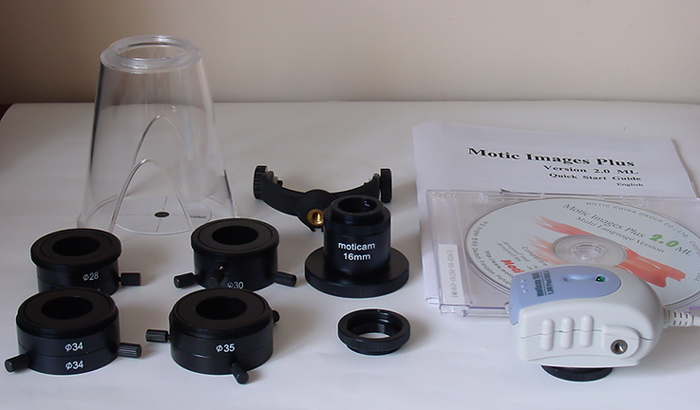
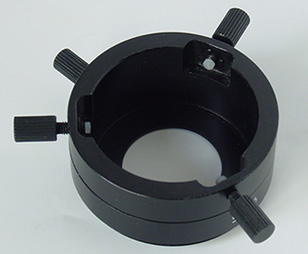
Left: Moticam
1000 outfit. Four
metal couplings are included for 28, 30, 34 and 35 mm tubes. The
16 mm relay lens is shown to the right of these.
Right: The couplings are anodised metal, well machined and with attention to detail. The
three centring pegs have plastic tips to protect the microscope tube. The fourth
screw is a quick release attachment to the relay lens.
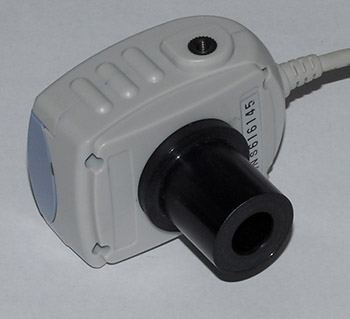
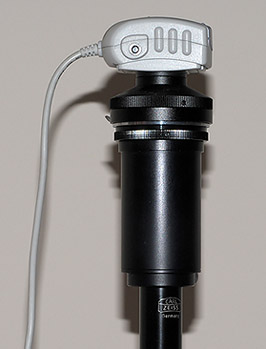
I often prefer not to use the couplers or the relay lens supplied with the
Moticam as find the relay lens tends to emphasise dust in the optics train. I prefer to
use two alternatives shown above:
Left above: A simple C-mount
to microscope tube connector, the sensor crop mag increase can be useful for
picking out fine detail e.g. of diatoms. (Many of the older objectives the author
uses seem tolerant of use without eyepiece, especially in monochromatic
light.)
Right above: When an eyepiece is desired, the Moticam is attached
to the microscope tube via a C-mount to 35 mm SLR mount adapter (in my case
a Nikon bayonet mount). These adaptors crop up on eBay quite a lot or are available
from larger camera accessory suppliers. This adaptor allows a third party 35
mm photo adapter to be used with eyepiece of choice.
So, this releases four
potentially useful adaptors. Or if one of the adaptors is only used, three can
be released for other purposes. A family consumer digicam that finds a lot of
use on both my and my brother's scope for quick but quality imaging is the 7
Mpixel, 3x optical zoom Sony
P200 shown below (essentially the same spec as the well regarded Sony W7). With
good light, the camera handheld to the eyepiece often suffices but the spare
Motic couplers can be used to make an excellent attachment for this sort
of camera.
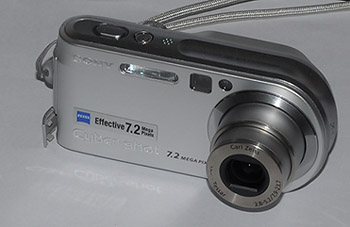
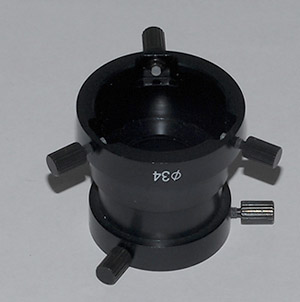
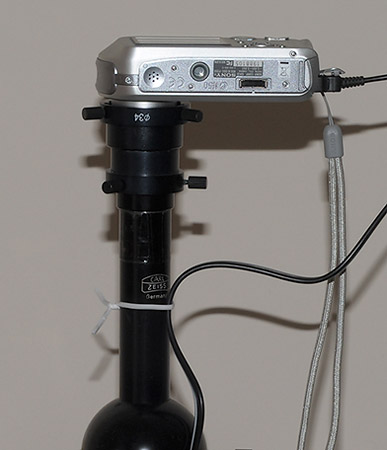
Like many modern consumer
digicams, the Sony P200 has a small two section zoom lens with metal mount,
but is unthreaded. Shown above (middle) is the Motic 28 mm and 34 mm couplers securely
attached face to face with Superglue (can be detached if ever needed with
acetone solvent). The adapter was dried thoroughly overnight in a warm place
before use near optics; the glue vapours may harm optics.
The 34 mm coupler snugly
fits on the zoom lens (above right), the nylon tips on screws preventing any damage
to the lens mount. The 28 mm coupler attaches to the microscope tube or larger
eyepieces like the Zeiss Kpl range. The two sets of centring screws allow accurate alignment
of mount to eyepiece and camera to mount. With care, the camera can be used
on batteries with the coupler as long as 3 minutes aren't left without use,
otherwise the zoom may try to shut down with potential damage to electronics.
With the mains cable / charger attached the camera stays on. Strapping
the mains cable to the tube (above right) takes weight off the camera.
The slightest loosening
of one centering screw releases the camera lens, so easy to install / reinstall
camera without losing centering.
The Motic couplers have
thin metal faces so the camera lens is supported a few millimeters above
the eyepiece, thus allowing full eyepiece field or optical zoom in with 3x lens
to remove vignetting. The zoom needs to be set by loosening a screw off a little
so the lens can rotate. I've used the camera successfully at the very highest
mags with tungsten lighting with no noticeable camera / shutter shake. Shown
below is an old slide of the test diatom Amphipleura pellucida (believe
to be mounted
in Realgar, unnamed mounter) showing the striae with a Zeiss 100/1.3 Neofluar objective
using oblique lighting.
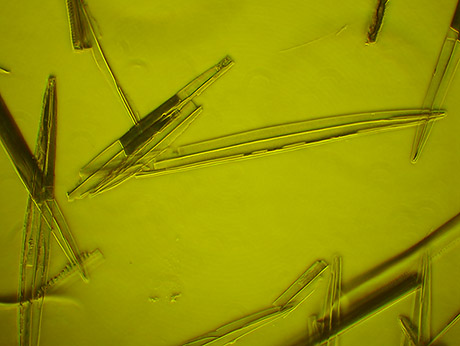
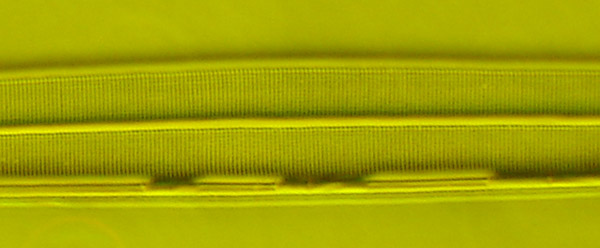
Left:
Full image field (3x zoom to remove vignetting) 1/15th sec, ISO 100. Right:
crop from image, unretouched. Diatom length typically 140 µm. The striae are shown and in places a hint
of some 'beading' which precludes punctae resolving. The mount is very yellow hence colour.
|
Right: The camera / mount was also able to image live organisms
that were not too active with a modest shutter speed of 1/125th
sec as shown for this freshwater rotifer (Possibly Euchlanis sp.?)
|
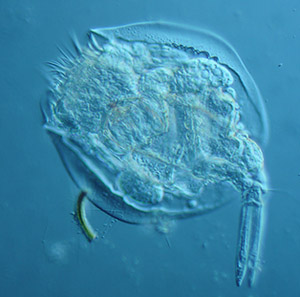
|
Comments to
the
author
David
Walker
are welcomed.
©
Microscopy UK or their contributors.
Published
in the December 2007 edition of Micscape.
Please
report any Web problems or offer general comments to
the
Micscape
Editor
.
Micscape
is the on-line monthly magazine of the Microscopy UK web
site at
Microscopy-UK
©
Onview.net Ltd, Microscopy-UK, and all contributors 1995
onwards. All rights reserved.
Main site is at
www.microscopy-uk.org.uk
with full mirror
at
www.microscopy-uk.net
.









